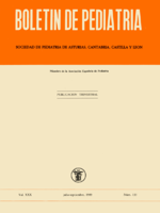Participación cardíaca en la hipoxia perinatal
M. Sánchez Martín , M.C. Pedraz García , A. Gil Sánchez , V. Salazar Alonso-Villalobos
Bol. Pediatr. 1989; 30 (133): 213 - 224
Con el fin de detectar las manifestaciones cardíacas en la hipoxia perinatal se estudian en 29 recién nacidas los antecedentes perinatales, manifestaciones clínicas, radiológicas, electrocardiográticas, ecocardiográficas y enzimáticas. Con la concordancia de todos ellos se diagnosticaron seis recién nacidos (20,68 %) con isquemia miocárdica transitoria. Los signos clínicos más frecuentes fueron cianosis (50 %), bradicardia (50 %) y cardiomegalia cardiológica (66.66 %). Los signos de isquemia electrocardiográfica fueron significativamente más frecuentes (p < 0.05) en los recién nacidos con manifestaciones cardíacas (83,33 %) que en los recién nacidos sin ellas (52,17 %), en todos ellos el grado más frecuente fue el 3, mostrando alteraciones de los percentiles para la amplitud de las ondas el 100% de los recién nacidos con manifestaciones cardíacas frente al 65% de las que no las presentaron. Los valores de CPK total y CPK-MB no mostraron diferencias significativas entre los recién nacidos con hipoxia perinatal con o sin manifestaciones cardíacas y otro grupo control. Los valores de CPK total mostraron diferencias significativas (p < 0.05) con los grados de isquemia electrocardiográficos.
Cardiacal participation in perinatal hypoxia
With the purpose of detecting cardiacal symptoms in perinatal hypoxia, the perinatal antecedents, clinical, radiological, electrocardiographic, echocardiographic and enzimatic findings have been estudied in 29 newborns. With the combined data of all of them, six newborns (20,68%) were diagnosed with transient myocardial ischemia. The most frequent clinical findings were cyanosis (50%), bradicardia (50%) and radiological cardiomegaly (66,66%). The electrocardiographic ischemic signs were significantly more frequent (p <0.05) in the newborns with cardiacal symptoms (83.33%) than in the newborns without these (52.17%), in all of them the most common grade of ischemia was 3; percentile variations in the amplitudes of the waves could be seen in 100% of the newborns with clinical symptoms compared with 65% of those without. The total CPK and CPK-MB showed no differences between the newborns with perinatal hypoxia with or without cardiacal symptoms and another control group. The total CPK values showed significant differences (p < 0.05) from the ischemic electrocardiographic grades.
Artículo completo (PDF) (575 kb.)
- Neonatología
